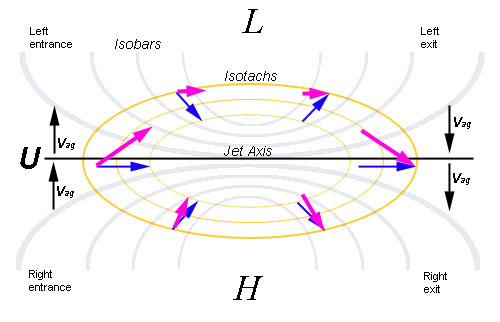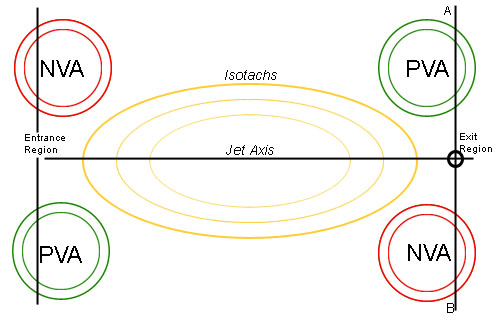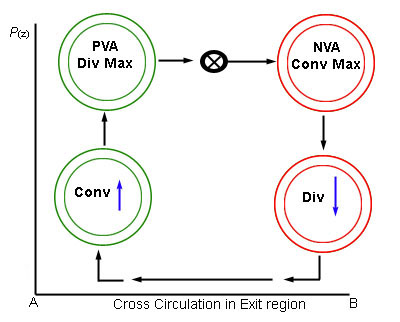In this case Jet played an important role in the development of a cyclone in the Mediterranean. It is therefore important to explain how the circulation around the jet axis and the lifting mechanisms in entrance and exit region of the jet streak are connected to the development and depening of the cyclone.
The key parameters that show the influence of the Jet are:
- Positive Vorticity Advection (PVA)
- Isotachs
The regions of strong positive vorticity advection are marked by PVA and they coincide with regions of intensified cloudiness.
The presence and location of the Jet is represented by the Isotachs, which stand for the lines of equal speed. The 'maximum' observed speed indicates
the location and orientation of a Jet Streak. The increase of cloudiness or PVA
can be found in the right entrance and left exit region of the jet streak.
To simplify this the following schematics of an idealised
Jet Stream that you normally only (and always) see in the text books might help.

Fig. 1 Jet Stream orientated
between isobars
In this figure the height contours between a low and high pressure system
and a Jet, orientated from west to east, are pictured. The geostrophic
component of the wind is represented by the blue arrows, which are parallel
to the isobars, and the isotachs are pictured in red. Due to an increase
in gradient of height contours, air will accelerate in the entrance region,
whereas on the exit side, the gradient of height contours slackens, leading
up to a deccelleration of the air flow. Now, according to the equation
of motion:

It follows that an ageostrophic wind, Vag, will develop.
On the entrance side of the Jet Streak the ageostrophic component will
be positive and blow from south to north, wheras on the exit side Vag
is negative, e.g. blow from north to south. The further away from the
jet the more this component of the wind will weaken.
The
total wind speed, pictured as the orange arrows, is the sum of the geostrophic
and the ageostrophic components of the wind. Focusing on these arrows
it becomes clear that convergence is associated to NVA and can be found
at the left entrance and right exit region of a Jet Streak and divergence
is associated to PVA and can be found at the right entrance and left exit
region of a Jet Streak.

Fig. 2 Jet Stream orientation and position of the PVA and NVA maxima.
These regions of divergence and convergence at
the upper levels of the troposhere (300 hPa) also induce a pair of horizontal
divergence and convergence at the surface causing a secundary circulation
(Holton, 1982). The associated upward motion causes cyclogenesis. It is
therefor that cyclogenesis and cloud enhancement is favoured in the left
exit and right entrance region of a Jet Streak.
A final step is to present a vertical cross section which is laid from position A to B in Figure 2.

Fig. 3 Vertical cross section in the exit region.
The vertical Cross Sections shows thare areas which are characterised by their PVA and NVA maxima. Subsequently the cyclonic motions associated to the
PVA maximum causes the air to rise, which explains the convergence near the surface and the divergence at jet level. Over the area of the NVA convergence takes place at jet level and
due to the decending air Near the surface divergence is observed.
References
- Holton, J. R., 1992: An Introduction to Dynamic Meteorology. 3d ed. Academic
Press.



